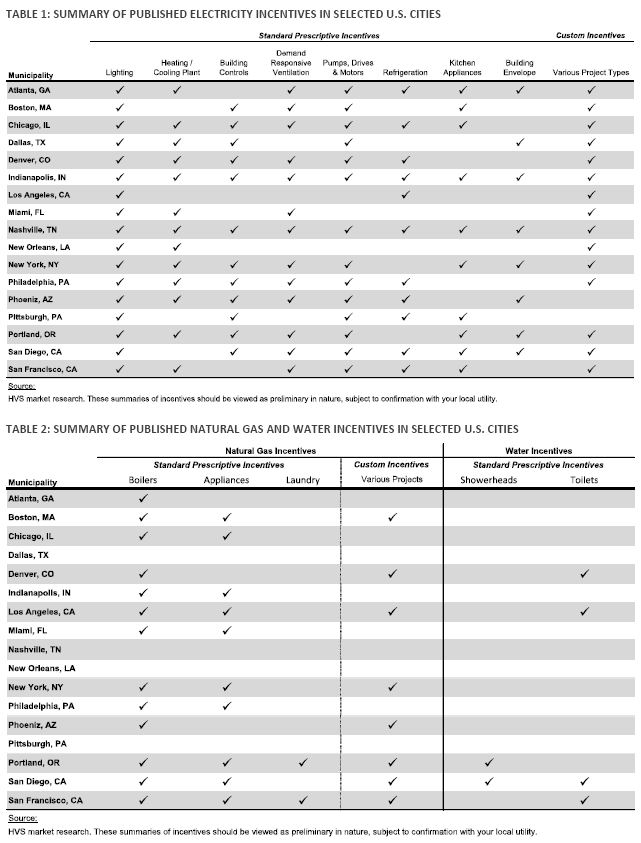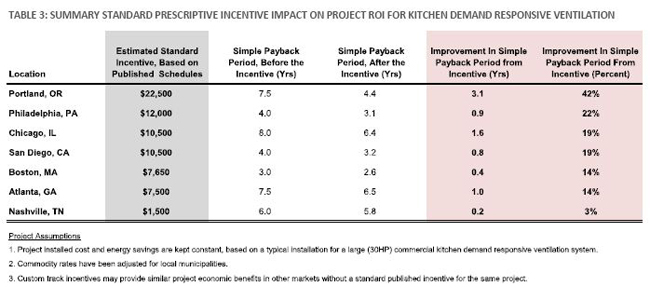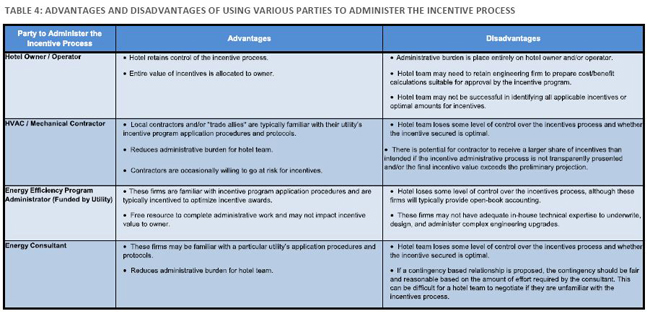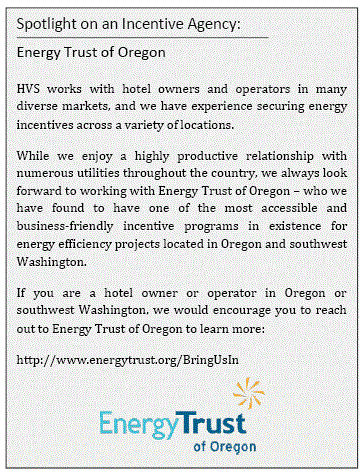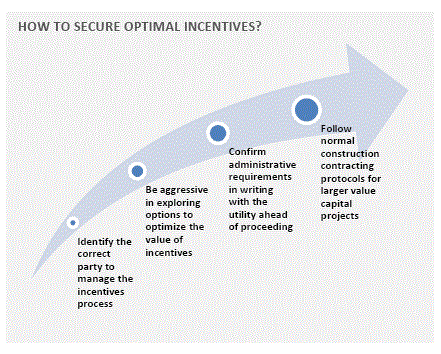By Kevin A. Goldstein and Sonia Vasquez, Dec 14, 2015
Financial incentives and rebates available from utility providers and municipalities can significantly improve the economics of Return on Investment (ROI) projects. This article provides practical guidance on how to identify and secure incentives.
Introduction
There are many types of incentives available to improve the economics of utility efficiency ROI projects. These include cash incentives and rebates, tax incentives, regulatory incentives (e.g. expedited construction permitting), and other novel mechanisms. For the purposes of this article, we primarily focus on the cash incentives and rebates, as well as processes that hotel owners and operators can consider to optimize incentive values and mitigate project financial risk.
Cash incentives and rebates are typically offered by utilities in order to enhance project economics to the point where building owners will consider execution of energy efficiency projects, which may otherwise be off the table. Most equipment rebates are offered on a standardized basis, while cash incentives can take the form of both standard and customized offerings.
Types of Incentives
Standard incentives, sometimes referred to as “prescriptive” in nature, are available in fixed amounts based on predetermined energy savings calculations. A fairly typical example of a standard incentive would be $5.00 per lamp for each incandescent lamp replaced with an LED equivalent. Standard incentives are typically published annually by a utility or the utility’s third-party incentive program manager.
To secure a standard incentive, the applicant is usually required to submit a simple application form that identifies the particular equipment to be replaced. In some circumstances, the utility may require a pre-or post-installation walkthrough to verify that the energy efficient equipment has been installed in accordance with program requirements.
Custom incentives, on the other hand, typically require preparation and submittal of much more detailed engineering-grade calculations that confirm a project’s anticipated cost/benefit. Custom incentive applications are reviewed by the utility’s in-house engineers or third party engineers, and the incentive award is typically made on a per-unit of energy saved basis. The value of custom incentives varies market by market, but in some municipalities an incentive on the custom track can offset up to 50% of a project’s construction cost.
For example, if an energy efficiency project is modeled to save 10,000 kilowatt hours (kWh) of electricity, it could be eligible for a custom incentive of $0.10 per kWh saved (or $1,000 total). In some cases, custom incentives may require more detailed monitoring and verification to confirm that the project is performing according to expectation, and the incentive payment may be tied into actual project performance over time.
Availability of Incentives in Individual Markets
The incentives that are available to hotel owners and operators vary widely market by market. In some circumstances, energy incentives are established at the state level by the Public Utilities Commission and allocated locally by individual utilities, whereas in other markets the individual utilities themselves establish their own incentive programs.
Based on our own experience in sourcing utility incentives, HVS has found that the best way to identify utility incentives is usually through web-based research based on geography and utility service providers. Oftentimes, a simple Internet search for “[City Name] Energy Incentives” will reveal key offerings in a certain market. The utility’s websites themselves (as well as conversations with your utility account manager) are also good places to search for incentive offerings and values schedules.
Tables 1 and 2 provide a snapshot summary of the various types of standard and custom incentives available in a representative sampling of U.S. cities. These lists of incentives should be viewed as preliminary in nature, given that incentive programs change frequently based on utility mandates and availability of funding. However, these tables do clearly indicate that utility incentive offerings vary widely by location.
Typical Incentive Impact to Project Economics
Utility incentives typically reduce project costs by 10% – 25% (equivalent to improving the simple payback period by approximately 1 –2 years). This accomplishes the utility’s intent of bringing more potential projects to the table for owners who may have strict investment thresholds.
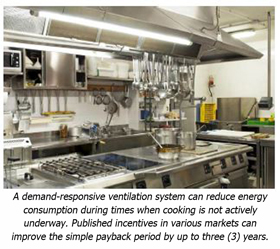
To provide a comparative review of the financial impact of incentives, HVS evaluated an identical project in seven municipalities with available standard prescriptive DRV incentives. To support a side-by-side comparison, we held project cost and savings constant in each of the examples, while modifying the incentive amount and local electricity rate for each city.
Across the seven cities, the available incentive ranged from $1,500 to $22,500, which improved the project simple payback period by 0.2 to 3.1 years. See Table 3 below for the estimated payback periods, by market. This simple analysis confirms that energy incentives can improve project economics anywhere from a modest to a significant extent. Since energy efficiency projects tend to have numerous input variables, HVS nearly always recommends site-specific underwriting rather than using industry-standards for payback periods.
Who Secures the Incentives?
There are several different methods to secure energy incentives. The best approach is usually asset-specific and is dictated by the local incentive program requirement, as well as owner/operator preference regarding who will undertake the actual administrative work. Potential methods to consider include:
- Hotel owner/operator secures the incentive. The most straightforward manner is for a hotel operator (or owner) to apply for incentives directly with the utility. However, this approach assumes that hotel personnel have adequate time and technical expertise to identify ROI opportunities and accompanying incentives, as well as follow application protocols established by the utility.
- Use an HVAC/MEP contractor. In many municipalities, contractors are familiar with the local utilities’ application procedures and protocols and can manage the incentive process. In some locations, contractors are pre-vetted by the utility for their capabilities to handle the administrative aspects of the incentive award process.
- Use a third party energy efficiency firm funded by the utility. In some municipalities, utilities contract with third-party energy efficiency firms to administer energy incentive programs. In these situations, the third-party firms are typically compensated directly by the utility and provide free support to confirm project eligibility and streamline the submittal of application paperwork.
- Use an energy consultant. There are also specialized energy consultants that are willing to provide management and administration of the incentives process, in many cases for a contingency fee based on the value of the incentive(s) secured.
Each of the approaches outlined above has very distinct advantages and disadvantages which can impact projects in the identification, underwriting, design, and execution phases. See Table 4 for a summary of each of these approaches.
What is Incentive Risk?
Regardless of which party is chosen to secure incentives, owners and operators should be aware that there is some level of risk inherent in the incentives process – primarily that the incentive may not be awarded in the amount initially estimated as part of project underwriting. Until the incentive is confirmed in writing with the utility, this risk is nearly always present.
In many circumstances, contractors are willing to assume some or all of the incentive risk. HVS is not opposed to this, as it can benefit both the contractor (through increased transactions) and owner/operator (through reduced underwriting time). However, we are typically more supportive of this approach for standard prescriptive incentives, since the incentive value can be easily estimated and understood by all parties. We encourage owners and operators to ask for copies of the finalized incentive paperwork, to ensure that the appropriate share of the incentive due to the hotel is distributed accordingly.
Are Incentives Available for Project Soft Costs?
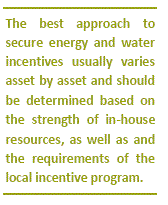
Alternatively, if the hotel is free to select their own MEP or project management consultant, we note that subsidized engineering studies may require more detailed analysis than would typically be required to achieve a “go” or “no-go” decision for a particular project. This soft cost is typically passed on to the hotel by the engineering consulting firm. So, although an engineering evaluation may be eligible for a 50% cost-share from the utility, the study itself may require an additional 25% of time and effort to comply with incentive program administrative and technical requirements, therefore reducing the owner’s actual out of pocket cash outlay by approximately 33% (which would be less than the 50% initially contemplated).
Our Recommendations for Securing Optimal Incentives
Based on our experience in securing incentives in many municipalities, HVS provides the following guidance for hotel owners and operators to consider as you negotiate the occasionally complex incentive process:
Carefully identify the party to administer the incentive process. The hotel’s goal should be to put as much of the incentive as possible into the owner’s pocket in order to provide the most favorable project economics. If a third-party is going to administer the incentives, then the owner/operator should attempt to negotiate an hourly, lump sum, or contingency-based fee that is fair and reasonable based on the amount of work required to secure the incentive, as well as which party is assuming the incentive risk.
Explore options to maximize incentives. The hotel can consider bundling projects together, exploring the customized incentive track rather than the standard prescriptive track, and also asking their utility if there are any bonus incentives available (typical for end of the year, when utility incentive programs may need to offload surplus incentive funds).
Confirm administrative process in writing with the utility. Just because an incentive is published on a website does not mean that funding is actually available, or that a particular project is eligible for funding. HVS strongly recommends that hotel owners and operators should receive written confirmation of incentives ahead of green-lighting an ROI project to move forward.
Use normal construction bidding and contracting protocols for larger capital intensive projects. In our experience, incentives usually take a good project and make it better, but only rarely take a bad project and turn it into a good one. With this in mind, hotel owners and operators should prioritize having the right project devised by the right technical services firm and installed by the right contractor over just securing an incentive – especially when there is a large amount of capital at risk.
Closing Thoughts
The rebates and cash incentives provided by numerous utilities can enhance the economics of energy efficiency ROI projects–in some cases significantly.
Hotel owners and operators should consider the impact of incentives within their ROI project identification and underwriting process, in order to have a solid understanding of the highest and best use of capital for a particular asset.
We strongly encourage hoteliers to become familiar with local incentive programs and to execute informed relationships with your consultants and contractors in order to optimize the benefit available to you.
HVS Energy & Sustainability provides Owner’s Representation, Project Management, and Utility Benchmarking services relating to a wide range of utility efficiency projects including large-scale HVAC and MEP retrofits. In addition to successfully identifying, underwriting, and delivering numerous back of the house equipment replacements, we have secured over US $1M in utility incentives for our clients in recent years.
Although the incentive process can occasionally be complex to navigate, we believe that hotel owners and operators who fund energy efficiency projects without a dedicated focus on securing incentives are leaving cash on the table.


